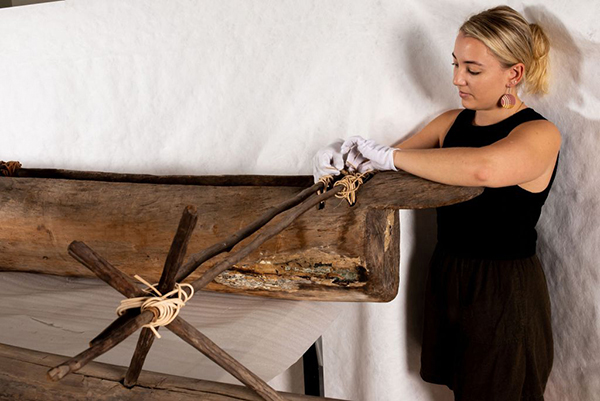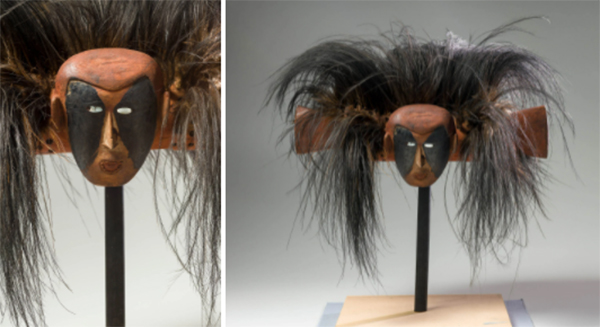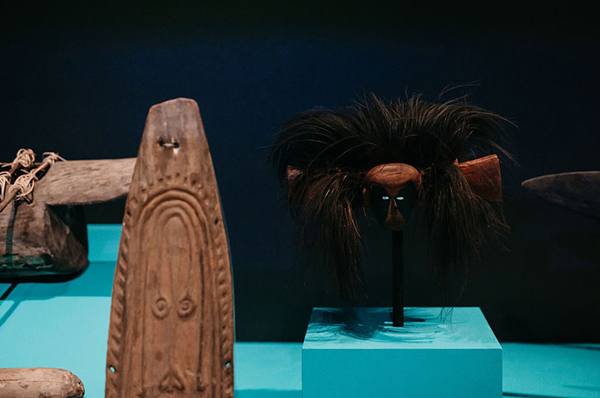Sophie Price, Curating ‘Connections across the Coral Sea’, Queensland Museum, 10 February 2022
Connections across the Coral Sea reveals the latest archaeological research around the earliest movements and trade between the seafaring cultures of Papua New Guinea, Torres Strait and the northeast coast of Queensland.
Every new exhibition gives us an opportunity to reassess how we curate and develop displays. How can objects be used to tell a story? More importantly, whose story, and which story are we telling?
We began curating Connections across the Coral Sea: a story of movement many months ago. From the start, we had a key focus: to highlight the movement of objects – in time and place – and show how the concept of movement can influence the way we tell stories in an exhibition.
An underlying message of this exhibition is that objects are not simply inanimate things used by communities and collected by museums. They are dynamic – entwined with stories, with history, with their own ‘biographies’ that evolve and change, depending on where they are from, who uses them, and how they are kept.
An example of this is one of the incredible items featured in Connections across the Coral Sea.

This large bunul (canoe) is from Yarrabah, east of Gimuy (Cairns), where the Traditional Owners are the Gunggandji people. The term bunul also means mullet (Gunggay dialect, Yidiny language), and reflects the way the canoe skims across the water with ease.
Canoes are vital to the connections created across the Coral Sea region, and the stories told in this exhibition. To those who craft and use them, canoes are animate, living beings. Imbued with spiritual meaning and connections, how a canoe is treated, and how it is made, can influence the safety of one’s journey across the sea.

To give more context to the bunul in the exhibition, we chose to feature it alongside a group of other items, used regularly on seafaring journeys across the Coral Sea. With the bunul is a pair of basor – coconut shell water containers – which were often hung from the side of a canoe to be kept cool in the sea water. Next to the basor is garai, or rolled pandanus leaves, used to create woven canoe sails, mats, and baskets.

“The basor is made from the mature coconut fruit shell. Our ancestors used the coconut shell from the Au Lid Lid UU (big coconuts). Firstly, newly brown coconuts are collected, and the Mes (coconut husks) are removed on the Wett, the coconut husking stake. The round shell is then pierced at the drinking hole and the coconut water is then drained. The two shells are then secured under a Miskor (big clam shell). The coconut shell is then immersed in the sea for about two months, until the fleshy meat on the inside of the two shells disappears.” Maryann Sebasio, Erubam Elder
We also displayed an extraordinary 19th century canoe prow from Boigu in the Torres Strait. Canoe prows such as this were added to canoes for decoration and protection. The face on this prow represents dogai, a class of sorcerers who would provide spiritual protection for the crews using thousands of years of maritime knowledge to navigate across the open sea.

“Figureheads were used on the canoe as an adornment. Nudhuwa (skirt fibre) was usually suspended below the figurehead and adorned with bubwam (cowrie shell) and woez (small cowrie shells). This type of figurehead was placed on the prow of a war canoe with the cassowary feathers as a projection of the warriors in the canoe. The cassowary feathers indicate that would only be used in time of war”. Mariana Babia, Saibai
By displaying these items together, on open display, we were able to give the objects more space and a freer existence, rather than simply displaying them behind glass and without context (as exhibitions have done in the past). It was a move away from the ‘cabinets of curiosity’ style displays, where objects were taken from Country and placed in static, enclosed environments.

Along with these subtle display techniques, we also prioritised the inclusivity of language when it came to the objects and the places mentioned in the exhibition. Colonial institutions – museums, galleries, and libraries, for example – have historically reflected the practices of the ‘dominant culture’ and excluded First Nations languages from exhibitions and collection records in the past.
Working with communities to identify the correct use of language names has helped us reconnect almost all of the objects in this exhibition with their own names. In the display, all the items are called by their name first – and their English translation second. We’ve done the same with place names, challenging our audience to consider the complex history around the places we know so well.


Discover more about the research and stories from the exhibition with our exclusive Connections across the Coral Sea Exhibition Guide featuring behind-the-scenes essays and stories from curators and researchers. Available in store at the Queensland Museum shop in Brisbane and Townsville and online.
Written by Assistant Curator, Anthropology, Sophie Price.
See also: Connections across the Coral Sea

